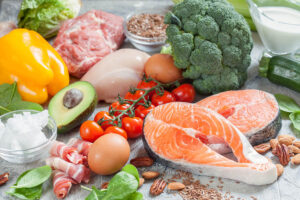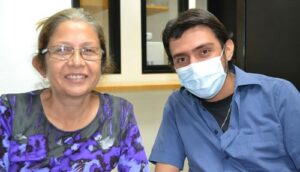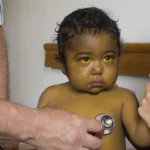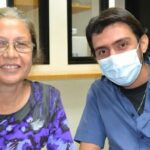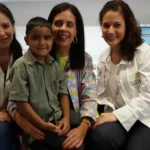What is the liver?
The liver is one of the vital organs of human beings and other vertebrate animals. In people it is located in the upper right portion of the abdomen and below the diaphragm, it has a triangular shape, an average weight in adults of 1.4 to 1.5 kilograms, dark reddish brown, and has a smooth surface and a soft consistency.
Among the main functions of the liver, we can mention:
- It produces the bile needed to break down fats during the digestion process. It also processes other foods until they become nutrients for the body.
- Store vitamins, iron, minerals, and branched chains of glucose called glycogen essential for the body to function correctly.
- Detoxify our body by breaking down chemical substances that are harmful to health such as ammonia by transforming it into urea.
- Helps fight infections and neutralize toxins.
Among the consequences that a patient can present when suffering from some type of liver disease, we have cirrhosis. In this sense, you may wonder what liver cirrhosis is like.
What is cirrhosis?
Cirrhosis usually occurs in patients with long-term or chronic liver disease. It is characterized because the liver presents an accumulation of scars, a product of the lesions that cause the disease and prevent the organ from performing its functions optimally, as it would when the liver tissue is completely healthy.
When some type of injury occurs in a person’s liver, either due to external factors (for example excessive alcohol consumption) or internal factors (such as a disease), the organ itself will try to repair itself, generating scarring during this process. As long as cirrhosis continues without the liver being able to heal itself, scarring in the liver tissue will increase, causing it to perform its functions with difficulty.
It should be taken into account that a patient diagnosed with cirrhosis early and treated according to medical recommendations, can stop the progress in the deterioration of their health. On the other hand, reversing the damage caused by liver cirrhosis is rarely achieved. To all these we can ask ourselves, why does liver cirrhosis occur? or why do I have cirrhosis of the liver?
Causes
The main causes that lead to developing liver cirrhosis are:
- Excessive or prolonged consumption of alcohol.
- Patients infected with viral hepatitis B, C, or D.
- Fatty liver disease (NAFLD), is caused by the accumulation of fat in the liver and that is not a product of chronic alcohol consumption.
- Hemochromatosis or excessive accumulation of iron in the body.
- Wilson’s disease, which is characterized by the accumulation of copper minerals in the body.
- A patient suffering from biliary atresia, product of malformed bile ducts.
- Autoimmune hepatitis disease, that is characterized in that the body’s immune system confuses healthy liver cells by attacking and damaging them.
- Suffering from galactosemia or glycogenosis, which consists of suffering from hereditary disorders of sugar metabolism.
- Liver-type diseases that are transmitted from one generation to another.
- Use or consumption of certain medications without medical supervision.
- Overweight or obese patients, which helps to develop a disease such as non-alcoholic steatohepatitis.
Symptoms Caused by Liver Cirrhosis
It must be taken into account that cirrhosis of the liver generally does not manifest any type of symptomatology in the patient, until the damage produced in the liver tissue is considerable and chronic, in which case the most frequent symptoms may be:
- Tiredness or fatigue of the patient without having carried out any activity that justifies it.
- Ease of bruising on the patient’s skin and nosebleeds.
- Manifestation of edema or swelling of the soft tissues due to accumulation of liquid, especially in the abdomen, legs, feet, and ankles of the patient.
- Frequent nausea.
- Unexplained weight loss.
- Renal insufficiency.
- Jaundice or yellowing of the skin and eyes.
- Hepatic encephalopathy due to the inability of the liver to eliminate toxins present in the patient’s bloodstream.
- Testicular atrophy in male patients.
- In certain patients, liver cirrhosis can develop into liver cancer.

How to prevent liver cirrhosis?
To reduce the risk of suffering from cirrhosis of the liver, we recommend that you take into account the following recommendations that allow you to take care of your liver:
- Do not exceed the consumption of alcoholic beverages. If you have been diagnosed with any type of liver disease, avoid alcohol consumption.
- Have a balanced and healthy diet that includes the consumption of vegetables, fruits, greens, whole grains, and lean or low-fat proteins. Limit the consumption of fats and fried foods.

- Maintain a controlled weight according to your physical constitution. Consult with specialists about your ideal weight, as well as a plan to lose weight if you are overweight.
- Reduce the risks of contracting diseases related to types of viral hepatitis A, B, C, and D. To do this:
- Avoid contact with blood and other bodily fluids of hepatitis B and D patients.
- Ask your treating doctor about available vaccines for viral hepatitis.
- Do not share a needle or have sexual intercourse without proper protection.
- Avoid eating food that is not properly cooked or handled under health criteria.



